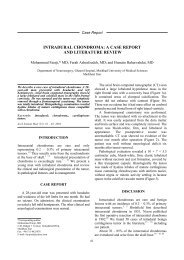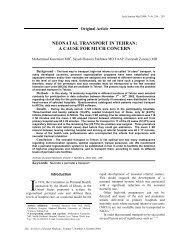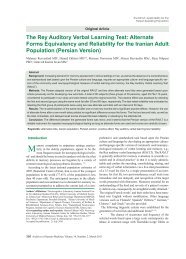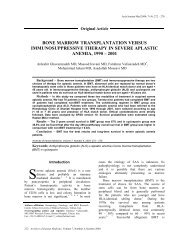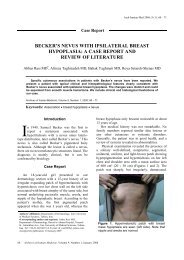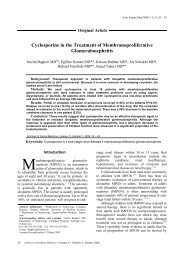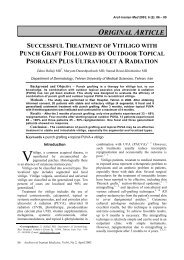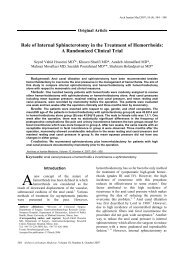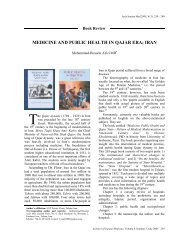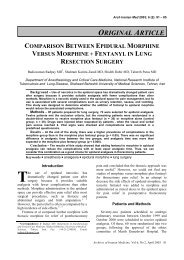risk factors of musculoskeletal disorders in bus drivers
risk factors of musculoskeletal disorders in bus drivers
risk factors of musculoskeletal disorders in bus drivers
You also want an ePaper? Increase the reach of your titles
YUMPU automatically turns print PDFs into web optimized ePapers that Google loves.
214<br />
Archives <strong>of</strong> Iranian Medic<strong>in</strong>e, Vol 6, No 3, July 2003<br />
Arch Iranian Med 2003; 6 (3): 214 – 215<br />
RISK FACTORS OF MUSCULOSKELETAL DISORDERS<br />
IN BUS DRIVERS<br />
Gholam-Hossa<strong>in</strong> Sadri PhD •<br />
Department <strong>of</strong> Epidemiology and Biostatistics, School <strong>of</strong> Health, Hamadan University <strong>of</strong> Medical<br />
Sciences, Hamadan, Iran<br />
ccupational <strong>disorders</strong> are important<br />
because they affect a large number <strong>of</strong><br />
workers. 1, 2 Pr<strong>of</strong>essional <strong>drivers</strong> have a<br />
higher prevalence <strong>of</strong> occupational <strong>disorders</strong> than<br />
other occupational groups. 3 W<strong>in</strong>kleby et al, 4 after a<br />
review <strong>of</strong> 22 epidemiological studies on <strong>bus</strong><br />
<strong>drivers</strong>’ <strong>disorders</strong>, put them <strong>in</strong> three ma<strong>in</strong> groups:<br />
cardiovascular, gastro<strong>in</strong>test<strong>in</strong>al, and<br />
<strong>musculoskeletal</strong> <strong>disorders</strong>. Several studies have<br />
shown that <strong>musculoskeletal</strong> <strong>disorders</strong> are more<br />
prevalent among <strong>bus</strong> <strong>drivers</strong>. 5 Backman <strong>in</strong> F<strong>in</strong>land<br />
reported an <strong>in</strong>creased <strong>in</strong>cidence <strong>of</strong> shoulder and<br />
back pa<strong>in</strong> <strong>in</strong> pr<strong>of</strong>essional <strong>drivers</strong>. 6 The occurrence<br />
<strong>of</strong> low back trouble among <strong>bus</strong> <strong>drivers</strong> and its<br />
relation with psychosocial parameters <strong>in</strong> the work<br />
was studied by Netterstrom and Juel. 7<br />
O<br />
The aim <strong>of</strong> the current study was to determ<strong>in</strong>e<br />
the frequency <strong>of</strong> <strong>musculoskeletal</strong> <strong>disorders</strong> <strong>in</strong> <strong>bus</strong><br />
<strong>drivers</strong> and its connection to some <strong>risk</strong> <strong>factors</strong> <strong>in</strong><br />
this pr<strong>of</strong>ession. The subjects <strong>of</strong> this study were 219<br />
<strong>bus</strong> <strong>drivers</strong> who worked for travel agencies <strong>in</strong><br />
Hamadan (a western prov<strong>in</strong>ce <strong>of</strong> Iran) and Yazd (a<br />
central prov<strong>in</strong>ce <strong>of</strong> Iran). The sample was<br />
randomly selected from travel companies’<br />
adm<strong>in</strong>istration lists <strong>of</strong> the <strong>bus</strong> <strong>drivers</strong> for each area.<br />
The sample was representative <strong>of</strong> 40% <strong>of</strong> the total<br />
<strong>bus</strong> <strong>drivers</strong> work<strong>in</strong>g <strong>in</strong> the two prov<strong>in</strong>ces. Among<br />
them, 68 were from Yazd and 151 from Hamadan.<br />
Accord<strong>in</strong>g to their work schedule, as far as the<br />
travel agencies were concerned, they had to drive<br />
<strong>in</strong> the <strong>in</strong>tercity routes, <strong>in</strong> different shifts dur<strong>in</strong>g day<br />
and night. All <strong>of</strong> the <strong>drivers</strong> were accompanied by<br />
conductors. Office workers were selected as the<br />
control group.<br />
All the <strong>bus</strong> <strong>drivers</strong> were <strong>in</strong>terviewed at their<br />
•Correspondence: G.H. Sadri PhD, Department <strong>of</strong><br />
Epidemiology and Biostatistics, School <strong>of</strong> Health, Hamadan<br />
University <strong>of</strong> Medical Sciences, Hamadan, Iran. Fax:+98-811-<br />
8255964, E-mail: ghsadri2000@yahoo.com.<br />
BRIEF REPORT<br />
coach or <strong>bus</strong> term<strong>in</strong>al before they started their<br />
journeys. Work conditions <strong>factors</strong> such as work<br />
hours and ergonomical <strong>factors</strong> were considered and<br />
exam<strong>in</strong>ed accord<strong>in</strong>g to the known hypothesis that<br />
there is a relationship between the <strong>musculoskeletal</strong><br />
<strong>disorders</strong> and such <strong>factors</strong>. Drivers’ perception<br />
such as <strong>drivers</strong>’ seat, position <strong>of</strong> steer<strong>in</strong>g wheel,<br />
brake, accelerator, and gear lever on the <strong>bus</strong> were<br />
assessed us<strong>in</strong>g a four-po<strong>in</strong>t scale (1 = just<br />
satisfactory, 2 = good, 3 = very good, 4 =<br />
excellent). A questionnaire was completed to f<strong>in</strong>d<br />
out the characteristics <strong>of</strong> each subject such as age,<br />
duration <strong>of</strong> the job, education, physical exercises,<br />
and makes and models <strong>of</strong> the vehicles. In this<br />
study, all the <strong>bus</strong>es were Mercedes-Benz, model<br />
302, made <strong>in</strong> Germany.<br />
As it can be seen from Table, <strong>bus</strong> <strong>drivers</strong> and<br />
<strong>of</strong>fice workers differ greatly <strong>in</strong> the number <strong>of</strong><br />
<strong>musculoskeletal</strong> <strong>disorders</strong>. The <strong>disorders</strong> were<br />
more prevalent among the <strong>bus</strong> <strong>drivers</strong> than <strong>in</strong> the<br />
control group and the difference was statistically<br />
significant. In the <strong>bus</strong> <strong>drivers</strong> who experienced<br />
back pa<strong>in</strong>, the numbers <strong>of</strong> hours spent <strong>in</strong> the job,<br />
driv<strong>in</strong>g hours per week, and average cont<strong>in</strong>uous<br />
driv<strong>in</strong>g hours per day were higher than <strong>in</strong> those<br />
who did not experience the pa<strong>in</strong>.<br />
There was a significant relation between the<br />
presence <strong>of</strong> back pa<strong>in</strong> and <strong>drivers</strong>’ perception <strong>of</strong><br />
the poor position <strong>of</strong> the driver’s seat and gear<br />
lever; the <strong>drivers</strong> suffer<strong>in</strong>g from back pa<strong>in</strong><br />
Table. Musculoskeletal disordrs <strong>in</strong> <strong>bus</strong> <strong>drivers</strong> compared<br />
to <strong>of</strong>fice workers.<br />
Musculoskeletal<br />
disorder<br />
Bus<br />
driver<br />
Office<br />
worker<br />
p<br />
Value<br />
Decision<br />
Low back pa<strong>in</strong><br />
106<br />
(48.4%)<br />
50<br />
(21.2%)<br />
0.003 Sig<br />
Back pa<strong>in</strong> 81 (37) 11 (4.7) 0.003 Sig<br />
Leg pa<strong>in</strong> 60 (27.4) 25 (10.6) 0.003 Sig<br />
Neck pa<strong>in</strong><br />
Sig = significant.<br />
35 (16) 13 (5.5) 0.003 Sig
specified that the positions <strong>of</strong> the driver’s seat and<br />
the gear lever were poor. No significant<br />
relationship was found between the <strong>bus</strong> <strong>drivers</strong><br />
experienc<strong>in</strong>g back pa<strong>in</strong> and the follow<strong>in</strong>g <strong>factors</strong>:<br />
body mass <strong>in</strong>dex (28.38), age (40.54 years), and<br />
job experience (10.37 years).<br />
Neck pa<strong>in</strong> was also more prevalent among the<br />
<strong>bus</strong> <strong>drivers</strong> with long driv<strong>in</strong>g hours (15%) than <strong>in</strong><br />
those with short driv<strong>in</strong>g hours (5.5%); the relation<br />
was statistically significant (p = 0.003). Accord<strong>in</strong>g<br />
to the evidence derived from this study, we can<br />
po<strong>in</strong>t to the statistical range <strong>of</strong> <strong>risk</strong> <strong>factors</strong> lead<strong>in</strong>g<br />
to a particular set <strong>of</strong> diseases that may affect <strong>bus</strong><br />
driver’s health. Our results showed that back pa<strong>in</strong>,<br />
neck pa<strong>in</strong>, and leg pa<strong>in</strong> were much more common<br />
<strong>in</strong> the <strong>bus</strong> driver group than <strong>in</strong> the control group.<br />
Backman, hav<strong>in</strong>g done a cross-sectional study <strong>in</strong><br />
F<strong>in</strong>land, suggested that there was an <strong>in</strong>creased<br />
<strong>in</strong>cidence <strong>of</strong> shoulder and back pa<strong>in</strong> <strong>in</strong><br />
pr<strong>of</strong>essional <strong>drivers</strong>, especially <strong>in</strong> <strong>bus</strong> <strong>drivers</strong>.<br />
Patterson et al also found that <strong>musculoskeletal</strong><br />
<strong>disorders</strong> were the most prevalent health problem<br />
<strong>in</strong> <strong>bus</strong> <strong>drivers</strong>; this study showed that back pa<strong>in</strong> is<br />
more prevalent among the <strong>bus</strong> <strong>drivers</strong> who<br />
compla<strong>in</strong> about their seats. This result is <strong>in</strong><br />
agreement with Kompier’s observations. 9 In our<br />
study, the mean driv<strong>in</strong>g hours <strong>of</strong> the <strong>bus</strong> <strong>drivers</strong><br />
who had back pa<strong>in</strong> was higher than that <strong>of</strong> those<br />
without back pa<strong>in</strong>. This result is <strong>in</strong> agreement with<br />
Patterson’s observation. 8 F<strong>in</strong>ally, <strong>of</strong> the<br />
<strong>musculoskeletal</strong> <strong>disorders</strong>, leg pa<strong>in</strong> was reported<br />
to be more frequent among the <strong>drivers</strong> for whom<br />
the mean <strong>of</strong> driv<strong>in</strong>g hours was longer. This result<br />
is also <strong>in</strong> agreement with Patterson’s study.<br />
From this study, it can be concluded that <strong>bus</strong><br />
G.H. Sadri<br />
<strong>drivers</strong>’ <strong>musculoskeletal</strong> <strong>disorders</strong> like back, neck,<br />
and leg pa<strong>in</strong> were relevant to some occupational<br />
<strong>risk</strong> <strong>factors</strong>. Therefore, it is necessary to consider<br />
the importance <strong>of</strong> these f<strong>in</strong>d<strong>in</strong>gs and f<strong>in</strong>d out<br />
possible solutions.<br />
References<br />
1 Bildt C, Alfredsson L, Punnett L, et al. Effects <strong>of</strong><br />
drop out <strong>in</strong> a longitud<strong>in</strong>al study <strong>of</strong> <strong>musculoskeletal</strong><br />
<strong>disorders</strong>. Occp Environ Med. 2001; 58: 194 – 9.<br />
2 Santos Filho SB, Barreto SM. Occupational activity<br />
and prevalence <strong>of</strong> osteomuscular pa<strong>in</strong> among dentists<br />
<strong>in</strong> Belo Horizonte, M<strong>in</strong>as Gerais State, Brazil: a<br />
contribution to the debate on work-related<br />
<strong>musculoskeletal</strong> <strong>disorders</strong> [<strong>in</strong> Portuguese]. Cad Saude<br />
Publica. 2001; 17: 181 – 93.<br />
3 Bylund P, Biornstig U, Lasson T. Occupational road<br />
trauma and permanent medical impairment. Safety<br />
Science. 1997; 26: 203 – 6.<br />
4 W<strong>in</strong>kleby M, Ragland D, Fisher J, et al. Excess <strong>risk</strong><br />
<strong>of</strong> sickness and disease <strong>in</strong> <strong>bus</strong> <strong>drivers</strong>: a review and<br />
synthesis <strong>of</strong> epidemiological studies. Int J Epidemiol.<br />
1988; 17: 255 – 62.<br />
5 Magnusson ML, Pope MH, Wilder DG, et al. Are<br />
occupational <strong>drivers</strong> at an <strong>in</strong>creased <strong>risk</strong> for<br />
develop<strong>in</strong>g <strong>musculoskeletal</strong> <strong>disorders</strong>? Sp<strong>in</strong>e. 1996;<br />
15: 710 – 7<br />
6 Backman A. Health survey <strong>of</strong> pr<strong>of</strong>essional <strong>drivers</strong>.<br />
Scand J Work Environ Health. 1983; 9: 30 – 5.<br />
7 Netterstrom B, Juel K. Low back trouble among urban<br />
<strong>bus</strong> <strong>drivers</strong> <strong>in</strong> Denmark. Scand J Soc Med. 1989; 17:<br />
203 – 6.<br />
8 Patterson PK, Eubanks TL, Ramseyer R. Back<br />
discomfort prevalence and associated <strong>factors</strong> among<br />
<strong>bus</strong> <strong>drivers</strong>. AAOHN J. 1986; 34: 481 – 4.<br />
9 Kompier M, De-Vries M, van-Noord F, et al. Physical<br />
work environment and <strong>musculoskeletal</strong> <strong>disorders</strong> <strong>in</strong><br />
the <strong>bus</strong> <strong>drivers</strong> pr<strong>of</strong>ession. In: Buckle P, ed.<br />
Musculoskeletal Disorders at Work. London, New<br />
York: Taylor and Francis; 1987: 17 – 22.<br />
Archives <strong>of</strong> Iranian Medic<strong>in</strong>e, Vol 6, No 3, July 2003 215



